48.6 Common Tab
The Common tab includes the following pages:
48.6.1 Macros Page
The Macros property page is available on Application objects created for all application types (simple, AOT/AXT, MSI, Web, and terminal server).
The Macros property page, shown below, displays the macros that have been defined for use with the Application object. For information about the Application object fields that support macros, see Section 49.8, Application Object Properties Where Macros Can Be Used
Figure 48-43 Application Object > Common Tab > Macros Page
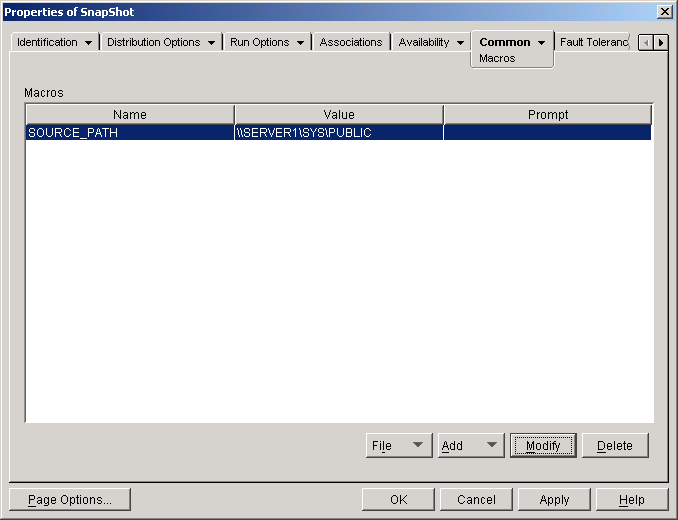
These macros, referred to as Application object macros, are simply variable names that are associated with values, typically string values.
For example, when you create an Application object using an .aot or .axt file, a SOURCE_PATH macro is automatically added to the list. This macro defines the location of the source files from which the application is installed. Many times, you must enter the source path when defining other properties for the Application object. By creating a SOURCE_PATH macro, you only need to enter %SOURCE_PATH% rather than the actual source path.
IMPORTANT:When using a macro for any of these properties, you must enclose the macro name in % characters (for example, %SOURCE_PATH%).
Macros
The Macros list displays all macros that have been defined for use with the Application object.
File
This option lets you search for specific macro information and import macros from other Application objects.
Click , then choose one of the following options:
-
Find: Searches for specific information in the , , and fields.
-
Find next: Finds the next occurrence of the information.
-
Import: Imports macros from another Application object’s .aot or .axt file. The Open dialog box defaults to *.axt for its file type display. If you are importing from an .aot file, you must change the file type display to *.aot or All files in order to select the .aot file.
Add
Use the Add button to define an Application object macro and add it to the Macros list. You can add either a String Value macro or a Prompted macro.
String Value
A String Value macro is used to create a variable that has a string value associated with it. This lets you use the variable in multiple locations while defining the value in one location.
To create a String Value macro, click > to display the Edit String Value dialog box. In the Value Name box, type a name for the variable, then type the value for the variable in the Value Data box. Click to add the macro to the Macros list.
You can place macros within macros. In the following example, a special Windows macro, *WINDISK, is used when defining the TARGET_PATH macro:
Value Name: TARGET_PATH Value Data: %*WINDISK%\Program Files
When embedding another macro in the string, you must enclose the macro in % characters, as shown in the above example. You can embed special Windows macros, eDirectory attribute macros, environment variable macros, login script macros, language variable macros, and other Application object macros. For information about these types of macros, see Section 49.0, Reference: Macros.
Prompted
A Prompted macro is used to create a macro that prompts the user to accept a default value (either a drive or string) or enter a new value. There are two types of Prompted macros: macros and macros. Because Windows Installer, and not Application Launcher, controls the installation of MSI applications, macros do not work with MSI applications.
To create a macro, click > > to display the Prompted Drive Macros dialog box. Fill in the fields as described below:
-
Macro name: Give the macro any name you want. Do not use spaces.
-
Prompt text: Specify the text you want presented to users. For example, “This application will be installed to your C: drive. Enter a different drive letter if desired:”
-
Default value: Select the drive that is used if the user does not enter another drive letter.
-
Minimum disk space in MB: Specify the minimum amount of free disk space required to install the application.
To create a macro, click > > to display the Prompted String Macros dialog box. Fill in the fields as described below:
-
Macro name: Give the macro any name you want. Do not use spaces.
-
Prompt text: Specify the text you want presented to users.
-
Default value: Select the value that is used if the user does not enter another value in response to the prompt text.
-
Minimum disk space in MB: Specify the minimum amount of free disk space required to install the application.
-
Maximum string length in chars: Specify the maximum number of characters the user can enter as a response to the prompt.
Modify
Select the macro whose information you want to modify, then click .
Delete
Select the macro you want to delete, then click .
48.6.2 Drives/Ports Page
The Drives/Ports property page is available only on Application objects created for simple applications, AOT/AXT applications, and MSI applications. It is not available on Application objects created for Web applications and terminal server applications.
The Drives/Ports property page, shown below, determines the drive mappings and port captures for the application. Drive mappings and port captures are performed by the workstation’s network clients, not by Application Launcher. This requires that the workstation have the network clients (for example, the Novell Client and the Microsoft Client) needed to perform the mappings and captures.
Figure 48-44 Application Object > Common Tab > Drives/ports Page
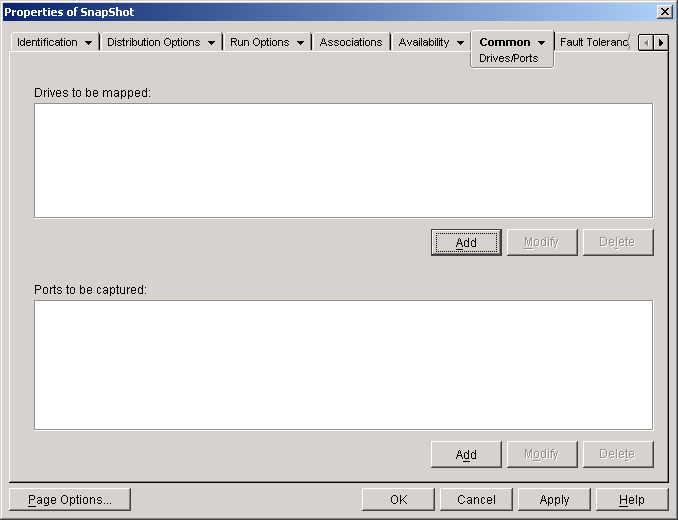
For example, suppose you’ve set up a database application to run from drive W:. To ensure that W is mapped to the location of the application, you could map drive W: to the server, volume, and directory where the application exists. When Application Launcher runs the application, it establishes the drive mapping according to the conditions defined when setting up the drive mapping.
Or, maybe users need access to a network location to store files created with a word processor. If you map a drive, the drive mapping becomes active as soon as the application runs.
By default, drive mappings and port captures are released when the user closes the application. If several launched applications use the same drive mappings or port captures, the drive mappings and port captures aren’t released until the last application terminates. If you don’t want drive mappings and port captures released, you must deselect the option ( > page).
Drives to Be Mapped
The list displays all drives that are mapped before the application is launched.
Add
Click to display the Drive to Be Mapped dialog box. Fill in the following fields:
-
Root: Select this option to treat the path as the root of the drive.
-
Option: Select the type of drive to map. The available types are:
-
DRIVE: Select this option to map to a drive letter (A through Z).
-
S1: Select this option to assign the drive to the first available search drive.
-
S16: Select this option to assign the drive to the last search drive.
NOTE:Starting with ZENworks for Desktops 4.x, selecting the S1 or S16 option does not affect the system's global path. Only applications started by this NAL process uses this search path; applications external to the NAL process cannot use this search path.
-
-
Drive: Assign a drive letter. The options are drives A through Z, or the next available drive.
-
Path: Enter, or browse and select, the path you want mapped to the selected drive. If you enter the path, use the following syntax:
- server\volume:path
- \\server\volume\path
- volume_object_name:path
- directory_map_object_name:path
- driveletter:\path
You can also use a macro in this field. For information about macros, see Section 49.0, Reference: Macros.
-
Map if drive mapping doesn't exist or same as existing: Select this option if you want Application Launcher to map the drive if 1) it doesn’t exist already or 2) it is the same as an existing drive mapping.
-
Overwrite any existing drive mapping: Select this option if you want Application Launcher to replace any mapping that uses the requested drive letter. For example, if S: is mapped to \\server1\sys\public and you’ve specified the new S: drive mapping as \\server1\apps\timecard, the end result is that drive S: is mapped to \\server1\apps\timecard.
To identify this option in the list, the word FORCE is added to the mapping information.
-
Use the existing drive mapping if already mapped: Select this option to use the existing drive mapping even if it is not the same as the path requested. For example, if S: is mapped to \\server1\sys\public and you’ve specified the new S: drive mapping as \\server1\apps\timecard, the end result is that drive S: is still mapped to \\server1\sys\public.
To identify this option in the list, the word REUSE is added to the mapping information.
Modify
Select a drive mapping in the list, then click to display the Drive to be Mapped dialog box. Change the drive mapping information as needed. See the field descriptions above or click the button in the dialog box.
Delete
Select a drive mapping in the list, then click to remove the mapped drive.
Ports to Be Captured
The list displays all ports that are captured before the application is launched.
Add
Click to display the Ports to Be Captured dialog box. Fill in the following fields:
-
Port: Select an LPT port to assign to the printer or queue.
-
Printer or queue: Browse to select a printer or queue.
You can also use a macro in this field. For information about macros, see Section 49.0, Reference: Macros.
-
Capture flags: You can use this option to override notification, banner, and form feed settings defined on the user’s workstation. Whenever a user prints from the application, the settings you defined are used.
In the box, select the box for the corresponding setting you want to override. After you do this, the corresponding setting becomes active. Select the setting to turn it on. Leave the setting deselected to turn it off.
For example, if you select the box for and also select the box for , when the user prints a document, the Novell Client displays a Notify alert panel to indicate the completion of the print job, no matter which Capture settings are on the user’s workstation. However, if you select the box for but do not select the box for , when the user prints a document, the Novell Client does not display a Notify alert panel to indicate the completion of the print job, no matter which Capture settings are used on the user’s workstation.
Modify
Select a port capture in the list, then click to display the Ports to be Captured dialog box. Change the capture information as needed. See the field descriptions above or click the button in the dialog box.
Delete
Select a port capture in the list, then click to remove the captured port.
48.6.3 File Rights Page
The File Rights property page is available on Application objects created for simple applications, AOT/AXT applications, and MSI applications only. It is not available on Application objects created for Web applications and terminal server applications.
The File Rights property page, shown below, specifies the file, directory, and volume rights a user must have to run the application. This page applies only to NetWare file system rights. Microsoft Windows file system rights cannot be assigned through eDirectory.
Figure 48-45 Application Object > Common Tab > File Rights Page
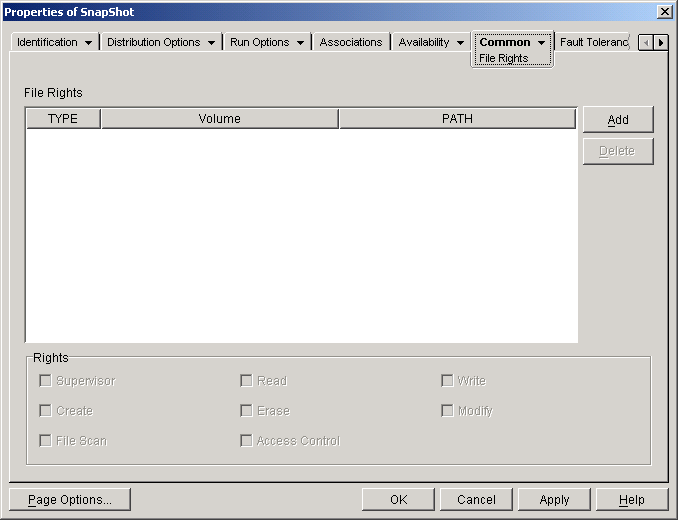
A user receives these NetWare rights when his or her User object is associated with the Application object, or when a Group, Organizational Unit, Organization, or Country object of which the user is a member is associated with the Application object. The rights are removed from the user when the object is no longer associated with the Application object.
The file rights you set up are not dependent on whether the user is actually using the application. The user has continual file rights from the time the Application object is associated with the user until the time the association is removed.
If two separate Application objects give file rights to the same file, directory, or volume and the user is unassociated with only one of them, then the user loses all rights even though the user might still be associated with the other Application object.
File Rights
The list displays all files, directories, and volumes to which rights are given. When you select a file, directory, or volume, the rights that have been granted are displayed in the Rights box. You can grant or remove rights by selecting or deselecting the appropriate check boxes.
Add
Click , browse for and select the file, directory, or volume you want to add, then click to display it in the list.
Delete
Select the file, directory, or volume you want to delete from the list, then click . Any users associated with the Application object lose rights to the file, directory, or volume.
Rights
Select the file, directory, or volume (in the list) for which you are establishing users' rights, then select the appropriate check boxes.
48.6.4 Reporting Page
The Reporting property page is available on Application objects created for all application types (simple, AOT/AXT, MSI, Web, and terminal server).
This section provides information about the fields located on the Reporting property page. For complete instructions on setting up reporting, see Reporting Application Events.
Use the Reporting property page, shown below, to enable Application Launcher to report event information for the application. You can define the events you want Application Launcher to report and also define the destination where you want to send the event reports.
Figure 48-46 Application Object > Common Tab > Reporting Page
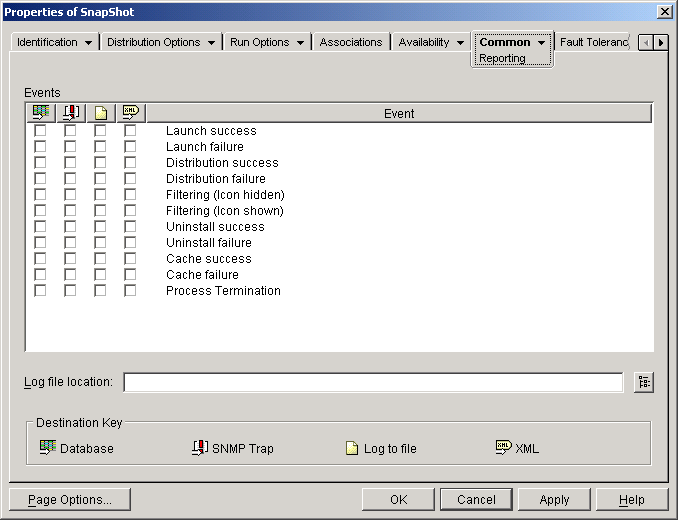
Reports contain the following information: event type, date and time, user distinguished name, workstation distinguished name, workstation address, application distinguished name, application global unique identifier (GUID), application version string, and event strings.
Events
Select the events you want reported and the destinations where you want them reported. If necessary, you can send an event report to multiple destinations. All events are described in the following table:
Table 48-3 Reporting Events
|
Event |
Description |
|---|---|
|
Launch Success |
Occurs when a user double-clicks the Application object and Application Launcher successfully starts the application. |
|
Launch Failure |
Occurs when a user double-clicks the Application object and Application Launcher cannot start the application. |
|
Distribution Success |
Occurs when Application Launcher successfully modifies the workstation to support the application. Modifications include installation of files, changing of settings (registry, INI, etc.), creation of shortcuts, and so forth. |
|
Distribution Failure |
Occurs when Application Launcher cannot modify the workstation to support the application. Modifications include installation of files, changing of settings (registry, INI, etc.), creation of shortcuts, and so forth. |
|
Uninstall Success |
Occurs when Application Launcher successfully uninstalls the application from the workstation. |
|
Uninstall Failure |
Occurs when Application Launcher cannot uninstall the application from the workstation. |
|
Cache Success |
Occurs when Application Launcher successfully caches the application to the workstation. |
|
Cache Failure |
Occurs when Application Launcher cannot cache the application to the workstation. |
|
Filter (Icon Hidden) |
Occurs when Application Launcher cannot display an Application object on a workstation because the workstation does not meet one or more of the Application object’s system requirements (Application object > Availability tab > System Requirements page) and the system requirement’s Show Application Icon Even If Criteria Are Not Met option is set to False. The Application object’s icon is hidden, or not shown, on the workstation. |
|
Filter (Icon Shown) |
Occurs when Application Launcher can only display a disabled (dimmed) Application object on a workstation. This occurs because the workstation does not meet one or more of the system requirements (Application object > Availability tab > System Requirements page) and the system requirement’s Show Application Icon Even If Criteria Are Not Met option is set to True. Users can right-click the disabled icon and click Details to see what system requirements are not being met. |
|
Process Termination |
Occurs when a user or Application Launcher terminates the application. |
All destinations are described in the following table:
Table 48-4 Reporting Destinations
|
Destination |
Description |
|---|---|
|
|
Application Launcher can write events to any ODBC-compliant database (for example, the Sybase database included with ZENworks). To use a database, you must also create a ZENworks Database object to use for Application Management reporting. This cannot be the same database object used for Inventory reporting.
|
|
|
Application Launcher can send SNMP traps to any SNMP management console. To use SNMP traps, you must also enable an SNMP Trap Target Policy in a Service Location Package. It might be necessary to first create the Service Location Package.
|
|
|
Application Launcher can write events to a text log file. You use the Log File Location field to specify the location of the log file. |
|
|
Application Launcher can send events, as XML data, to a URL using the standard HTTP or HTTPS protocol. XML reporting is the recommended method if you want Application Launcher to report events for users located outside of your firewall. To use XML, you must also:
|
Log File Location
If you selected a log file as the destination for any of the event reports, enter (or browse to and select) the location and name for the log file. You can specify a local drive or a network drive. If you enter a location that does not exist, Application Launcher creates it. Do not use extended characters in the path; extended characters are not supported.
If you want Application Launcher to log events to a file in a common network location, you need to establish the network directory and provide users with Read and Write rights to files in the directory. Because log file names are established on a per-application basis, you can have individual log files for each application (by specifying a different log file name for each Application object) or one log file for all applications (by specifying the same log file name for all Application objects).
IMPORTANT:You should use log file reporting only if users have a network client such as the Novell Client or Microsoft Client that enables writing to a NetWare, Linux, or Windows server, or if you specify a local drive as the log file location.
48.6.5 Imaging Page
The Imaging property page is available only on Application objects created for simple applications, AOT/AXT applications, and MSI applications. It is not available on Application objects created for Web applications and terminal server applications.
The Imaging property page, shown below, lets you create an image file for the Application object. You can use the image file as an add-on image to a base image file.
Figure 48-47 Application Object > Common Tab > Imaging Page
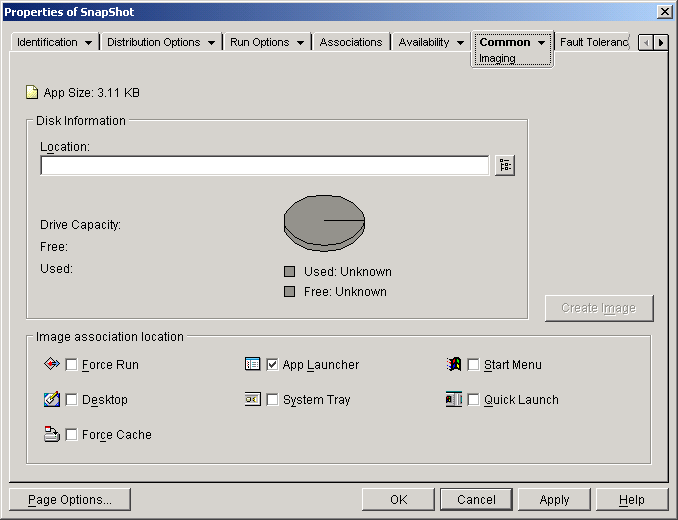
If the application includes any dependent applications ( object > tab > page), the dependent applications must also be included as add-on images if they have not already been distributed to the user's workstation.
App Size
This field displays the size of the of the Application object. This includes all Application object information and application source files (as listed on the Application Files page). This is the size of the image file if you do not use a compression option.
When you image an MSI Application object, ConsoleOne is unaware of the files referenced or included in the .msi file. Therefore, it includes the .msi file and all files and folders at the same level or below. This ensures that all related files are included with the .msi file, but might also result in non-related files being included. To avoid this situation, make sure the folder where the .msi file is located contains only the .msi file and its related files and folders.
Disk Information
These fields let you specify a location and filename for the image and ensure that the disk to which you are saving the image has sufficient free space.
Location
Specify the location and filename for the image. You might want to save it in the same location as the base image file. The filename must have a .zmg file extension.
Drive Capacity, Free, and Used
After you’ve entered a location for the file, these fields display the amount of space on the disk, the amount of available free disk space, and the amount of used disk space. Verify that the Application object fits in the amount of free disk space.
In addition to the image location, the NAL cache directory located on the workstation's Windows drive (typically c:\nalcache) is used temporarily to store the application's source files (.fil files) and the Application object's settings (.aot/.axt file). The size of the source files varies; the size of the settings file is typically less than 200 KB. Make sure that the workstation's Windows drive has sufficient disk space for these files.
Image Association Location
Specify the association characteristics for the Application object. These are enforced when the image is applied to the workstation.
Force Run
Automatically runs the application. With a user-associated application, the application is run immediately after Application Launcher starts. With a workstation-associated application, the application is run immediately after the workstation starts up (initial startup or reboot).
You can use the option in conjunction with several other settings to achieve unique behaviors. For example, if you use the option with the option ( tab > page), as soon as the Application object is distributed it runs one time and is removed from the workstation. Or, suppose that you want to run the Application object immediately one time at a predetermined time. If so, select , select the option on the Application page (Run Options tab), and define a schedule using the Schedule page (Availability tab).
If you want to force run several applications in a specific order, mark each of them as . Then give each Application object a numeric order by using the option on the Icon page (Identification tab).
App Launcher
Adds the Application object’s icon to the Application Window, the Application Explorer window, and the Application Browser window.
Start Menu
If the workstation is running Application Explorer, this option adds the Application object to the Windows Start menu. The Application object is added to the top of the Start menu, unless you assign the Application object to a folder and use the folder structure on the Start menu. See the Application object’s Folders page (Identification tab).
Desktop
If the workstation is running Application Explorer, this option displays the Application object’s icon on the Windows desktop.
System Tray
If the workstation is running Application Explorer, this option displays the Application object’s icon in the Windows system tray.
Quick Launch
Displays the Application object’s icon on the Windows Quick Launch bar.
Force Cache
Forces the application source files and other files required for installation to be copied to the workstation’s cache directory. The user can then install or repair the application while disconnected from eDirectory. The files are compressed to save space on the workstation’s local drive.
Create Image
After you've defined the image location and selected the image associations, click the button to create the image. A dialog box appears that lets you select from the following compression options:
-
None: Creates the image file but does not compress it. This results in the largest image size produced by any of the compression options.
-
Optimize compression time: Applies the lowest level of compression. This minimizes the time required to compress the image file, but results in a larger file size than could be achieved by using the option or option.
-
Balance compression time and image size: Applies a medium level of compression in order to balance the amount of time required to compress the file against the size of the image file.
-
Optimize image size: Applies the highest level of compression. This decreases the image file size but increases the time required to compress the image file as compared to the option and option.
48.6.6 Sources Page
The Sources property page is available on Application objects created for simple applications, AOT/AXT applications, and MSI applications only. It is not available on Application objects created for Web applications and terminal server applications.
The Sources property page, shown below, specifies additional network locations that contain installation packages from which Application Launcher can distribute the application. If the Application object was created from an .aot or .axt file, the installation packages must be snAppShot packages (.aot, .axt, and .fil files). If the Application object was created from an .msi file, the installation packages must be Microsoft Windows Installer packages (.msi files). The source list is used only if the original source location is unavailable, in which case Application Launcher begins with the first location in the list and continues down the list until an accessible package is found.
Figure 48-48 Application Object > Common Tab > Sources Page
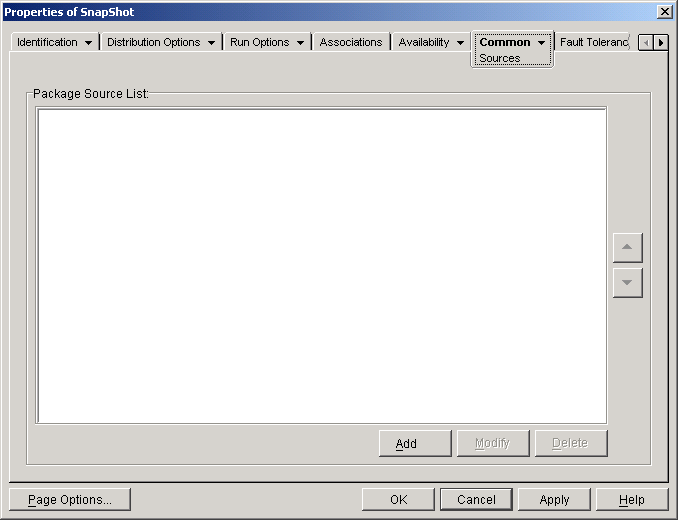
Before you can define additional source locations, you need to make sure to copy the original package to the new source locations. For snAppShot packages, copy the .aot, .axt, .fil, and .txt files. For Windows Installer packages, copy the administrative installation folder and all subfolders.
With Application objects that use an .msi file rather than an .aot or .axt file, this source list can be extremely important. Because Windows Installer supports on-demand installations (installation of files as the user requests certain features or components), the source list can provide source resiliency for installations that occur after the initial installation. If the original installation source is no longer available and no source list has been established, the on-demand installation fails. However, if you create additional source locations and define them in the source list, the on-demand installation has a better chance of succeeding.
IMPORTANT:If you have used the SOURCE_PATH macro (Common > Macros page) in any of the Application object’s property fields, you should verify that you used all uppercase letters and no lowercase letters. If the original source location is referenced through the SOURCE_PATH macro and Application Launcher cannot access the location, it uses the package sources in this list only if the SOURCE_PATH macro is all uppercase.
Package Source List
The list displays the additional package source locations that have been defined for the application. When the application is distributed to a workstation, Application Launcher uses these locations, in the order listed, if the original source location is unavailable.
When distributing applications that use the Windows Installer, Application Launcher passes the source list to the Windows Installer, which then uses the list for the locations from which to install the application files.
Add
To add a source location to the list, click , browse to and select the directory that contains the installation package, then click .
Delete
To remove a source location from the list, select the location > click .
48.6.7 Uninstall Page
The Uninstall property page is available on Application objects created for all application types (simple, AOT/AXT, MSI, Web, and terminal server).
This section provides information about the fields located on the Uninstall property page. For complete instructions on uninstalling applications, see Uninstalling Applications.
The Uninstall property page, shown below, enables the application to be uninstalled and determines the behaviors associated with uninstalling the application.
Figure 48-49 Application Object > Common Tab > Uninstall Page
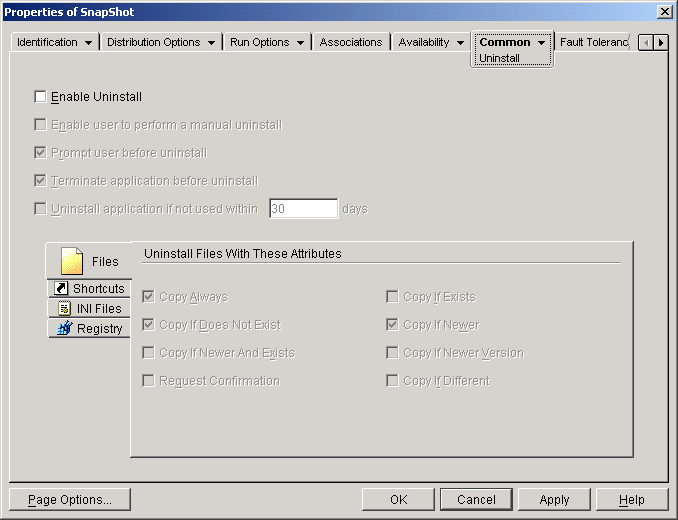
When Application Launcher distributes an application to a workstation, it creates a cache directory on the workstation that contains the information required to successfully uninstall the application. However, when Application Launcher distributes an application to a terminal server, it does not create a cache directory, which means that it does not have the information to uninstall the application from the terminal server. Therefore, the options on this page do not apply when the application is installed on a terminal server. If you no longer want the application on the terminal server, you must manually uninstall it.
Enable Uninstall
Select this option to enable the application to be removed from the workstation. The other uninstall options are available only if this option is enabled.
Enable User to Perform a Manual Uninstall
Select this option to enable users to remove the application from their workstations. If this option is not enabled, only you or other administrators can remove applications.
Prompt User Before Uninstall
Select this option to prompt users before removing the application from their workstations. If users answer “” to the prompt, the application is not removed.
Terminate Application Before Uninstall
Select this option to ensure that Application Launcher terminates the application (if the application is running) before it begins uninstalling the application files.
Uninstall Applications If Not Used Within XX Days
Select this option to automatically remove the application if the user has not run it within the specified number of days (the default is 30).
Files
Click , then select the attributes you want to use to determine whether or not a file is removed. The attributes correspond to the attributes listed on the Application Files page (Distribution Options tab). The default selections (, , ) ensure that a file is removed only if it was installed when the application was installed and not at an earlier time by another application that also needs the file.
Application Launcher does not uninstall files that are copied to the workstation using wildcards. For example, assume you copy \\server\vol\public\zenworks\sysapps\*.* to c:\winnt\system32. When you uninstall the application, its files are not removed from c:\winnt\system32. To perform an uninstall, Application Launcher simply reverses the install process, which means that if it uninstalled the files in the previous example, it would do so by doing a wildcard delete (delete c:\winnt\system32\*.*). Because this could have undesirable results, Application Launcher has been designed to not uninstall files that are copied using wildcards.
Shortcuts
Click , then select the attributes you want to use to determine whether or not the application’s shortcuts are removed. The attributes correspond to the attributes listed on the Shortcuts/Icons page (Distribution Options tab).
INI Files
Click INI Files, then select the attributes you want to use to determine whether or not an INI setting is removed. The attributes correspond to the attributes listed on the INI Settings page (Distribution Options tab). The default selections (, , ) ensure that a setting is removed only if it was created when the application was installed and not at an earlier time by another application that also needs the setting.
Registry
Click , then select the attributes you want to use to determine whether or not a registry setting is removed. The attributes correspond to the attributes listed on the Registry Settings page (Distribution Options tab). The default selections (, ) ensure that a setting is removed only if it was created when the application was installed and not at an earlier time by another application that still needs the setting.
Uninstall Keys/Values From These Registry Hives
This option allows you to select two specific registry hives, HKEY_LOCAL_MACHINE and HKEY_CURRENT_USER, to include or exclude when removing the registry settings that were added by Application Launcher during distribution of the application to the workstation. The default settings cause Application Launcher to remove settings from the HKEY_CURRENT_USER hive but not from the HKEY_LOCAL_MACHINE hive.
The purpose of this option is to help you ensure that no Windows system settings are removed during the uninstall. This is particularly important if you used snAppShot to capture the application’s installation. When snAppShot captures an application’s installation, it includes all settings that are changed during the installation. If the application’s installation program causes the workstation to reboot during the installation process, these changes can include not only settings that apply to the application but also settings that apply to the Windows system. Removing Windows system settings might cause the workstation to encounter problems when starting up. We strongly recommended that you remove these settings only if you are positive that they do not affect the workstation’s ability to function properly.
If you want to use this option, you should examine the registry settings that will be removed from the HKEY_LOCAL_MACHINE and HKEY_CURRENT_USER hives and delete any settings that apply to anything other than the application. The registry settings are displayed on the Registry Settings page (Distribution Options tab).
48.6.8 Uninstall Scripts Page
The Uninstall Scripts property page is available only on Application objects created for simple applications, AOT/AXT applications, and MSI applications. It is not available on Application objects created for Web applications and terminal server applications.
As part of the process of uninstalling the application, Application Launcher can launch a script engine to execute a “before uninstall” script and an “after uninstall” script. The Uninstall Scripts page, shown below, defines the script engine that you want Application Launcher to use and the scripts you want executed.
Figure 48-50 Application Object > Common Tab > Uninstall Scripts
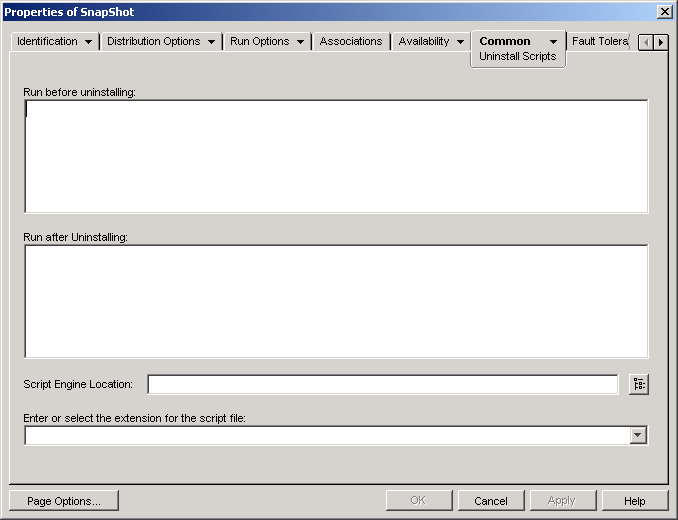
On Windows 2000/XP, uninstall scripts always run in the user space for both user-associated applications and workstation-associated applications. This is the same behavior as launch scripts ( tab > ) but different than the behavior for distribution scripts ( tab > ), which run in the secure system space.
Run Before Uninstalling
Use this text box to specify any script commands you want executed before the application is uninstalled. Do not use extended characters in the script; extended characters are not supported. For script example, see Script Example.
Run After Uninstalling
Use this text box to specify any script commands you want executed after the application is uninstalled. Do not use extended characters in the script; extended characters are not supported. For script example, see Script Example.
Script Engine Location
The script engine determines the script commands and scripting language you need to use. If you do not define a script engine in the field, Application Launcher uses the Novell Client as the script engine (if the workstation has the Novell Client installed), which means that you can use most Novell Client login script commands (see Supported Novell Client Login Script Commands).
If you want to use a script engine other than the Novell Client, specify the alternate script engine. The script engine must reside in a location that is always available to users, such as their local drives. The script engine can reside on a network server only if users can map a drive to the server (for example, through the Novell Client or the Client for Microsoft Networks). If Application Launcher cannot find the script engine, it displays an error to the user and fails to uninstall the application.
If you use the Windows command interpreter as the script engine, you must include the /c switch, as shown in the following examples:
-
Windows 2000/XP: %*winsysdir%\cmd.exe /c
-
Windows 98: %*windir%\command.com /c
The %*winsysdir% and %*windir% variables specify the Windows system directory (for example, c:\winnt\system32), and the /c switch instructs the command interpreter to execute the script and then stop. If the /c switch is not used, the script does not complete.
For a script example, see Script Example.
Script File Extension
This applies only if you specified a script engine in the field.
When the application is uninstalled, Application Launcher creates temporary script files for the scripts and scripts. These files are passed to the script engine, which then executes the script. You need to specify the file extension that the script engine requires for its script files.
For a script example, see Script Example.
Script Example
The following script uses the Windows 2000/XP command interpreter as the script engine. Before the distribution occurs, a listing of the c:\ directory is saved to a text file and the autoexec.bat file is backed up.
Run Before Uninstalling Field
dir c:\ >c:\1.txt copy autoexec.bat autoexec.bak /y
Script Engine Location Field
cmd.exe /c
Enter or Select the Extension of the Script File Field
.bat
Supported Novell Client Login Script Commands
When using the Novell Client as the script engine, you can use all but the following script commands:
Table 48-5 Supported Novell Client Login Script Commands
|
CLS |
INCLUDE |
PCOMPATIBLE |
|
DISPLAY |
LASTLOGINTIME |
SCRIPT_SERVER |
|
EXIT |
NO_DEFAULT |
SET_TIME |
|
FDISPLAY |
NOSWAP |
SWAP |
|
IF MEMBER OF |
PAUSE |
WRITE |
Application Launcher does not output anything to the screen or display script errors.
For script commands, syntax, and examples, see the Novell Client documentation on the Novell Documentation Web site.
 Database
Database
 SNMP Traps
SNMP Traps
 Text Log File
Text Log File
 XML
XML